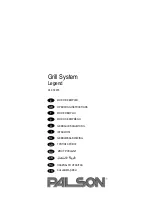
13
1.5.4. Keep the power cord a safe distance
from rotating work tools. If you lose control over the hammer drill, the cable can be cut or
fascinated by the working tool and it can cause injuries.
1.5.5. Never leave the hammer drill, before working tools to completely stop its rotation.
Rotary tool can touch the object, resulting in losing control over the hammer drill.
1.5.6. Regularly clean your vent striking drill.
1.5.7. Do not use the hammer drill near flammable materials. Flying sparks can cause the
ignition of such materials.
1.5.8. Never put your hands near the rotary working tools.
1.5.9. Use appropriate instruments to find any hidden beneath the surface pipelines, or
contact the appropriate local supply company. Into contact with the wires under tension can
cause fire or electric shock. Pipeline damage can lead to explosion. Deterioration of water has
the effect of major material damage and may cause electric shock.
1.5.10. If the supply voltage is interrupted (e.g. due to blackouts, or if the plug is removed
from contact) unblock the trigger switch and place it in position “off”. This will prevent
uncontrolled inclusion of the hammer drill.
1.5.11. During operation keep striking drill firmly with both hands and lend a stable position
of the body. With both hands striking drill is kept more secure.
1.5.12. Provide workpiece.
Detail, and attach with appropriate appliances or braces is anchored more firmly and
securely than if you hold it by hand.
1.5.13. Keep your workplace clean.
Mixtures of different materials are particularly hazardous. Fine shavings from light metals
can be self ignite or explode.
1.5.14. Do not use the hammer drill, where the power cord is damaged. If during operation
the cable is damaged, do not touch. Immediately disconnect the plug from the outlet.
Damaged power cables increase the risk of electric shock.
1.5.15. If the hammer is to be operated at low temperature or after long storage, allow
the hammer to operate for few minutes without load, for its internal elements get properly
lubricated.
Do not use three jaw drill chuck when the hammer drill is set to hammer drilling or chiselling
mode. This chuck is designed only for regular drilling in wood or steel.
Failure of the considered instructions may lead to electric shock, fire and / or severe injuries.
2. Functional description and purpose of the hammer drill.
Hammer drill is a hand-operated power tool with insulation class II. The tool is driven by
single-phase commutator motor. Hammer drill can be used for drilling holes in working mode
with hammer, digging channels, or surface processing of materials such as concrete, stone,
brick etc. Range of use covers repair and building works, and any work from the range of
individual, amateur-enthusiast DIY activities. Not permitted the use of power tools for activities
other than its intended purpose.
3. Information on noise and vibration emitted.
The values are measured according to EN 60745. A level of noise generated is generally:
the sound pressure level Lp
A
= 98 dB (A); sound power Lw
A
= 108 dB (A). Uncertainty K = 3 dB.
Work with a silencer! The resultant value of vibration (the vector sum of the three directions)
is determined according to EN 60745: Drilling in metal: the value of the emitted vibrations a
h
=
4,7 m/s
2
, uncertainty K = 1,5 m/s
2
, hammer drilling in concrete: value the emitted vibrations a
h
= 24,2 m/s
2
, uncertainty K = 2,0 m/s
2
.
That in this operating manual for the vibration value is measured by the method specified
in EN 60745 and can be used to compare different power. The level of vibration varies
depending on the specific activity carried out and in some cases may exceed that amount
in that direction. If power is used for a long time in this mode, the load caused by vibration,
could be underestimated. Directions: For an exact estimate of the burden of vibrations in a
working cycle should be recorded and the intervals in which the power is off or idling. This can
significantly reduce the reporting burden of vibrations throughout the business cycle.














































